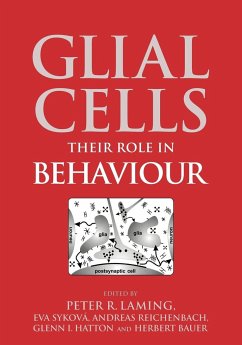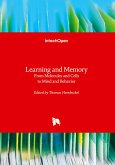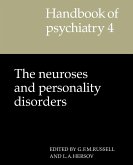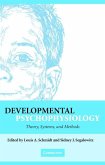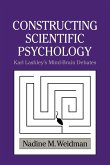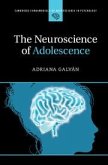- Broschiertes Buch
- Merkliste
- Auf die Merkliste
- Bewerten Bewerten
- Teilen
- Produkt teilen
- Produkterinnerung
- Produkterinnerung
This 1998 book discusses how neurons and glial cells interact with each other to influence behaviour.
Andere Kunden interessierten sich auch für
![Learning and Memory - From Molecules and Cells to Mind and Behavior Learning and Memory - From Molecules and Cells to Mind and Behavior]() Learning and Memory - From Molecules and Cells to Mind and Behavior135,00 €
Learning and Memory - From Molecules and Cells to Mind and Behavior135,00 €![Torture and Its Consequences Torture and Its Consequences]() Torture and Its Consequences103,99 €
Torture and Its Consequences103,99 €![Handbook of Psychiatry Handbook of Psychiatry]() Hdbk PsyHandbook of Psychiatry66,99 €
Hdbk PsyHandbook of Psychiatry66,99 €![Developmental Psychophysiology Developmental Psychophysiology]() Louis Schmidt / Sidney Segalowitz (eds.)Developmental Psychophysiology103,99 €
Louis Schmidt / Sidney Segalowitz (eds.)Developmental Psychophysiology103,99 €![Constructing Scientific Psychology Constructing Scientific Psychology]() Nadine M. WeidmanConstructing Scientific Psychology43,99 €
Nadine M. WeidmanConstructing Scientific Psychology43,99 €![Human Development across Lives and Generations Human Development across Lives and Generations]() P. Lindsay Chase-Lansdale / Kathleen E. Kiernan / Ruth J. Friedman (eds.)Human Development across Lives and Generations96,99 €
P. Lindsay Chase-Lansdale / Kathleen E. Kiernan / Ruth J. Friedman (eds.)Human Development across Lives and Generations96,99 €![The Neuroscience of Adolescence The Neuroscience of Adolescence]() Adriana GalvánThe Neuroscience of Adolescence114,99 €
Adriana GalvánThe Neuroscience of Adolescence114,99 €-
-
-
This 1998 book discusses how neurons and glial cells interact with each other to influence behaviour.
Hinweis: Dieser Artikel kann nur an eine deutsche Lieferadresse ausgeliefert werden.
Hinweis: Dieser Artikel kann nur an eine deutsche Lieferadresse ausgeliefert werden.
Produktdetails
- Produktdetails
- Verlag: Cambridge University Press
- Seitenzahl: 446
- Erscheinungstermin: 6. Dezember 2010
- Englisch
- Abmessung: 254mm x 178mm x 24mm
- Gewicht: 833g
- ISBN-13: 9780521183826
- ISBN-10: 0521183820
- Artikelnr.: 33154131
- Herstellerkennzeichnung
- Libri GmbH
- Europaallee 1
- 36244 Bad Hersfeld
- gpsr@libri.de
- Verlag: Cambridge University Press
- Seitenzahl: 446
- Erscheinungstermin: 6. Dezember 2010
- Englisch
- Abmessung: 254mm x 178mm x 24mm
- Gewicht: 833g
- ISBN-13: 9780521183826
- ISBN-10: 0521183820
- Artikelnr.: 33154131
- Herstellerkennzeichnung
- Libri GmbH
- Europaallee 1
- 36244 Bad Hersfeld
- gpsr@libri.de
Preface; 1. Changing concepts on the role of glia Peter Laming; 2. The
phylogeny of glial-neuronal relationships and behaviour Betty Roots and
Peter Laming; 3. Glial cells in brain development and plasticity Christian
Müller; 4. The retina as a model of glial function in the brain Andreas
Reichenbach, Serguei N. Skatchkov and Winfried Reichelt; 5. Metabolic
trafficking between neurons and glia Stephen R. Robinson, Arne Schousboe,
Ralf Dringen, Pierre Magistretti, Jonathan Coles and Leif Hertz; 6.
Transmitter receptor and uptake systems in astrocytes and their relation to
behaviour Harold K. Kimelberg, Tuula O. Jalonen, Chiye Aoki and Ken
McCarthy; 7. Glial regulation of the neuronal microenvironment Eva Sykova,
Elisabeth Hansson, Lars Rönnbäck and Charles Nicholson; 8. Role of
periaxonal glia in nerve conduction Joan Abbott; 9. Transplantation of
myelin-forming glial cells into the spinal cord: restoration of normal
conduction in previously demyelinated axons Jeffery D. Kocsis and Stephen
G. Waxman; 10. Contributions of potassium currents and glia to slow
potential shifts Uwe Heinemann and Wolfgang Walz; 11. Acid alkaline
transients and pH regulation glia Joachim Deitmer; 12. Intra-cranial slow
potential shifts and behavioural state Peter Laming, Alister Nichol and
John Roughan; 13. Slow brain potentials, sensory processing and cognition
Herbert Bauer, Niels Birbaumer and Frank Roesler; 14. Recent evidence from
around the brain for structural plasticity of astrocytes in the adult CNS
Adrienne Salm, N. Hawrylak, J. B. Bobak, G. I. Hatton and C. Aoki; 15.
Astrocytic involvement in learning Kim Ng, Ciaran Regan and Brona O'Dowd;
References; Index.
phylogeny of glial-neuronal relationships and behaviour Betty Roots and
Peter Laming; 3. Glial cells in brain development and plasticity Christian
Müller; 4. The retina as a model of glial function in the brain Andreas
Reichenbach, Serguei N. Skatchkov and Winfried Reichelt; 5. Metabolic
trafficking between neurons and glia Stephen R. Robinson, Arne Schousboe,
Ralf Dringen, Pierre Magistretti, Jonathan Coles and Leif Hertz; 6.
Transmitter receptor and uptake systems in astrocytes and their relation to
behaviour Harold K. Kimelberg, Tuula O. Jalonen, Chiye Aoki and Ken
McCarthy; 7. Glial regulation of the neuronal microenvironment Eva Sykova,
Elisabeth Hansson, Lars Rönnbäck and Charles Nicholson; 8. Role of
periaxonal glia in nerve conduction Joan Abbott; 9. Transplantation of
myelin-forming glial cells into the spinal cord: restoration of normal
conduction in previously demyelinated axons Jeffery D. Kocsis and Stephen
G. Waxman; 10. Contributions of potassium currents and glia to slow
potential shifts Uwe Heinemann and Wolfgang Walz; 11. Acid alkaline
transients and pH regulation glia Joachim Deitmer; 12. Intra-cranial slow
potential shifts and behavioural state Peter Laming, Alister Nichol and
John Roughan; 13. Slow brain potentials, sensory processing and cognition
Herbert Bauer, Niels Birbaumer and Frank Roesler; 14. Recent evidence from
around the brain for structural plasticity of astrocytes in the adult CNS
Adrienne Salm, N. Hawrylak, J. B. Bobak, G. I. Hatton and C. Aoki; 15.
Astrocytic involvement in learning Kim Ng, Ciaran Regan and Brona O'Dowd;
References; Index.
Preface; 1. Changing concepts on the role of glia Peter Laming; 2. The
phylogeny of glial-neuronal relationships and behaviour Betty Roots and
Peter Laming; 3. Glial cells in brain development and plasticity Christian
Müller; 4. The retina as a model of glial function in the brain Andreas
Reichenbach, Serguei N. Skatchkov and Winfried Reichelt; 5. Metabolic
trafficking between neurons and glia Stephen R. Robinson, Arne Schousboe,
Ralf Dringen, Pierre Magistretti, Jonathan Coles and Leif Hertz; 6.
Transmitter receptor and uptake systems in astrocytes and their relation to
behaviour Harold K. Kimelberg, Tuula O. Jalonen, Chiye Aoki and Ken
McCarthy; 7. Glial regulation of the neuronal microenvironment Eva Sykova,
Elisabeth Hansson, Lars Rönnbäck and Charles Nicholson; 8. Role of
periaxonal glia in nerve conduction Joan Abbott; 9. Transplantation of
myelin-forming glial cells into the spinal cord: restoration of normal
conduction in previously demyelinated axons Jeffery D. Kocsis and Stephen
G. Waxman; 10. Contributions of potassium currents and glia to slow
potential shifts Uwe Heinemann and Wolfgang Walz; 11. Acid alkaline
transients and pH regulation glia Joachim Deitmer; 12. Intra-cranial slow
potential shifts and behavioural state Peter Laming, Alister Nichol and
John Roughan; 13. Slow brain potentials, sensory processing and cognition
Herbert Bauer, Niels Birbaumer and Frank Roesler; 14. Recent evidence from
around the brain for structural plasticity of astrocytes in the adult CNS
Adrienne Salm, N. Hawrylak, J. B. Bobak, G. I. Hatton and C. Aoki; 15.
Astrocytic involvement in learning Kim Ng, Ciaran Regan and Brona O'Dowd;
References; Index.
phylogeny of glial-neuronal relationships and behaviour Betty Roots and
Peter Laming; 3. Glial cells in brain development and plasticity Christian
Müller; 4. The retina as a model of glial function in the brain Andreas
Reichenbach, Serguei N. Skatchkov and Winfried Reichelt; 5. Metabolic
trafficking between neurons and glia Stephen R. Robinson, Arne Schousboe,
Ralf Dringen, Pierre Magistretti, Jonathan Coles and Leif Hertz; 6.
Transmitter receptor and uptake systems in astrocytes and their relation to
behaviour Harold K. Kimelberg, Tuula O. Jalonen, Chiye Aoki and Ken
McCarthy; 7. Glial regulation of the neuronal microenvironment Eva Sykova,
Elisabeth Hansson, Lars Rönnbäck and Charles Nicholson; 8. Role of
periaxonal glia in nerve conduction Joan Abbott; 9. Transplantation of
myelin-forming glial cells into the spinal cord: restoration of normal
conduction in previously demyelinated axons Jeffery D. Kocsis and Stephen
G. Waxman; 10. Contributions of potassium currents and glia to slow
potential shifts Uwe Heinemann and Wolfgang Walz; 11. Acid alkaline
transients and pH regulation glia Joachim Deitmer; 12. Intra-cranial slow
potential shifts and behavioural state Peter Laming, Alister Nichol and
John Roughan; 13. Slow brain potentials, sensory processing and cognition
Herbert Bauer, Niels Birbaumer and Frank Roesler; 14. Recent evidence from
around the brain for structural plasticity of astrocytes in the adult CNS
Adrienne Salm, N. Hawrylak, J. B. Bobak, G. I. Hatton and C. Aoki; 15.
Astrocytic involvement in learning Kim Ng, Ciaran Regan and Brona O'Dowd;
References; Index.

